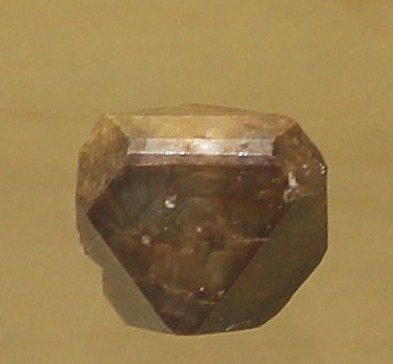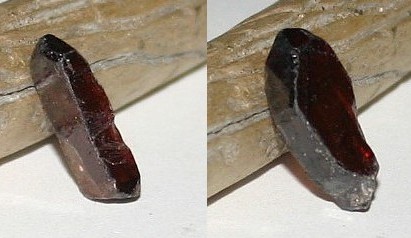|
.
Zircon
Mineral Facts:
Chemical Formula: ZrSiO4
Zirconium
Silicate. Although some specimens of zircon contain a large number of
elements, others consist only of zirconium, silicon and oxygen in
proportions
that correspond to the formula. Common impurities are hafnium (usually about
1 to 4%), rare earth elements, thorium and uranium.
Colors:
Usually
some shade of brown; also gray,
green, red, blue,
yellow and colorless.
Its streak is colorless.
Hardness:
7.5
Density:
4.68
Cleavage:
The cleavage of zircon is indistinct
on (110) and (111). Its fracture is conchoidal.
Crystallography:
Tetragonal
Usually crystallized; also in irregular grains. Crystal forms and axial ratios
prove a close relationship between
zircon and cassiterite, rutile and
xenotime. Elbow twins
of zircon, like those
of
rutile and
casseterite, are known. Internal
damage by traces of radioactive elements may cause the crystal to enter a
metamict state.
Luster:.
Adamantine, transparent, translucent
and opaque; The transparent forms are
used as a gemstone.
Optics: (Refractive Index) = w=1.9302, e=1.9832.
Zircon has an abnormally high
refractive index. |

Above: Gem quality Zircon from Sri Lanka
 |
|
Composition, Structure and
Associated Minerals:
Zircon is widely spread in tiny
crystals as a
primary constituent in many rocks, and in large crystals in a few, notably
in limestone and a granite-like rock known as nepheline syenite. Zircon is a
common and widely distributed accessory
mineral in all classes of igneous rocks. It is the first one among the
silicates to crystallize out from a cooling magma. It is especially frequent
in the more acid types such as granite, syenite, diorite, etc. Zircon is found commonly in
crystalline limestone, in gneiss, schist, etc. In
limestone it is a product of contact metamorphic action.
It occurs abundantly in a sandstone
near Ashland, Virginia.
It resists weathering,
and so it is concentrated as a residual heavy material in alluvial
sands where it if found frequently as small rounded pebbles. It has been
found as a heavy mineral in a number of gold bearing regions in stream sands, often closely
associated with gold. It has been found along with
gold nuggets in the gold
bearing gravels of the Urals in Russia, with
native gold in the sands of Australia,
etc. |

Red Zircon
Crystals, Tanzania |
|
|
Identification
and Diagnostics
Zircon is infusible,
though colored varieties often lose their color
when strongly heated. In the borax and other beads the mineral gives
no perceptible reactions. A small fragment
when intensely ignited
glows and gives off a white light.
In fine powder it is decomposed by concentrated
sulfuric acid. When fused with sodium carbonate
and fusion then dissolved in dilute hydrochloric acid, the
solution will turn a piece of turmeric paper to an orange color
(positive test for zirconium). Recognized usually by its characteristic crystals,
color, luster, hardness and high specific gravity.
Occurrence,
Localities and Origins:
Zircon is a
fairly common compound of a comparatively rare metal. It is practically the
only ore of the metal zirconium. It is found mainly in crystals and as
gravel. One of the best-known deposits of
zircon is that at Zirconia in
Henderson County, North Carolina, U.S.A., where there is a vein of
kaolinized zircon-bearing pegmatite 100 feet wide, extending over a
length of 15 miles. The zircon crystals are up to two inches or so in
length,
and have been obtained in large quantities from this vein.
Zircon also occurs in some abundance associated with rutile near
Gouldin in the Hanover county portion of the Virginia rutile area. In this district masses of zircon up to one or two
pounds in weight occur associated with large masses of rutile, in pegmatite
veins that traverse gneisses. Zircon-bearing pegmatites traversing
biotite-gneisses occur also in Amelia County, Virginia. It is noteworthy
that zircon is often very abundant in the
naturally-concentrated portions of stream and beach deposits. It
occurs abundantly in the alluvial gem gravels of Ceylon; and in the
monazite concentrates of Brazil,
Australia and India. The non-magnetic portion
of the monazite sand of the Travancore beaches in India, consists almost
entirely of zircon; and the stream and beach deposits of many other
localities contain the mineral in abundance. It is from these heavy sand
sources that all industrial zircon for chemical use is recovered.
It occurs at Arendal,
Hakedal and other places in Norway; Litchfield and other points in
Maine; Diana, in Lewis Co., and a large number of other places in New
York; at Reading, Penn.; Henderson and other Counties, in North
Carolina and Templeton, Ottawa Co., Quebec.
A small quantity of zircon is usually obtained from
Henderson Co., N. C., but it rarely amounts to more than a few hundred
pounds. The mineral occurs in a pegmatite and the soil overlying its
outcrop. It is obtained by crushing the rock and hand picking. Usually
there is a little also separated from the sands in North Carolina and
South Carolina that are washed for monazite. A pegmatite dike, rich
in zircon, has been prospected in the Wichita Mountains, Okla., but
no mining has yet been attempted.
Industrial Uses of Zircon
Zircon serves as the
only important zirconium ore and source of zirconium salts including zirconium
oxide, which is used in the manufacture of many
refractory materials, as both zircon and zirconium oxide are an important refractories.
Industrial zircon is directly consumed
as a opacifier in the decorative ceramics industry.
Industrial grade zircon is also used in
chemically aggressive environments, such as moulds for molten metals.
Zirconium metal is used in a number of alloys to impart chemical resistance,
and for cladding nuclear reactor fuel rods
used in generating power.
Transparent orange-colored zircons are sometimes used as gems
since they possess a high index of refraction
and attractive adamantine luster so it consequently has
a great deal of "fire."
The gem varieties of this mineral vary in tint
from colorless, through yellowish brown to reddish brown to red. A fine blue
color is produced from some of the brownish shades by heat treatment. The
results of the treatment are permanent. Before the age of synthetic
substitutes, the colorless gem form of zircon was used as a substitute for
diamond,
because while resembling the diamond they were available for a much lower
price. The orange, brown and reddish
transparent kinds of this gem are sometimes known as hyacinth.
The principal occurrences of the gem form of
the mineral are in Sri Lanka, the
home of the gem hyacinth. Gem zircons are found in the stream sands at
Matura in Sri Lanka, but have also been recovered in Thailand, Myanmar and
at several locations in Africa, including Tanzania. Gem zircon has also been
mined in Australia.
.Return
to the
Mineral Collectors Information Page
|
|


